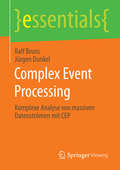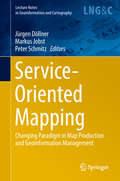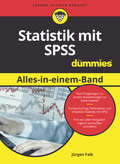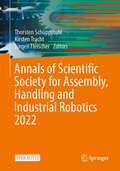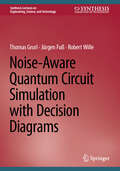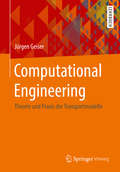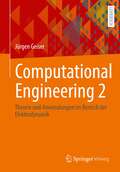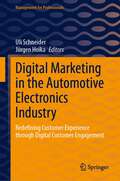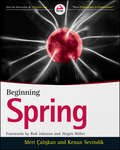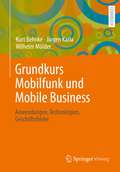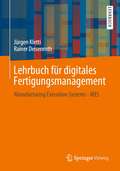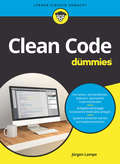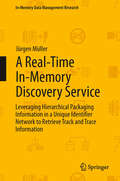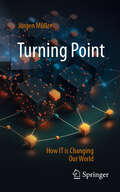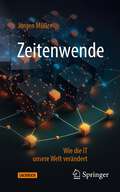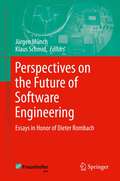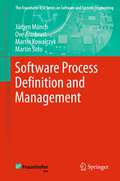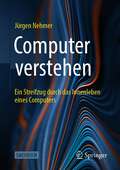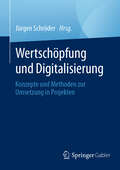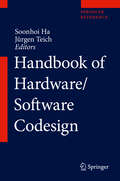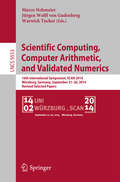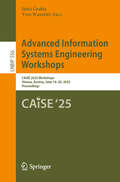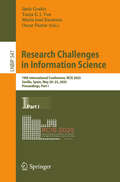- Table View
- List View
Complex Event Processing: Komplexe Analyse von massiven Datenströmen mit CEP (essentials)
by Ralf Bruns Jürgen DunkelRalf Bruns und Jürgen Dunkel bieten eine kompakte Einführung in die Grundprinzipien von Complex Event Processing (CEP), das eine extrem leistungsfähige Softwaretechnologie zur systematischen Analyse von massiven Datenströmen in Echtzeit darstellt. Die Autoren stellen die wesentlichen Sprachkonzepte der Ereignisverarbeitung Schritt für Schritt vor. Eine Fallstudie aus dem M2M-Bereich verdeutlicht die praktische Anwendung von CEP. Moderne Unternehmen stehen vor der Herausforderung mit immer größeren Datenmengen umgehen zu müssen. Neben immensen statischen Datenbeständen ist es entscheidend, auch kontinuierlich eintreffende Datenströme effizient zu nutzen, um geschäftliche Entscheidungen situationsabhängig treffen zu können. Mit CEP ist es möglich, hochfrequente Datenströme intelligent zu analysieren und daraus zeitnah operative Unternehmensentscheidungen abzuleiten. CEP steht für eine neue Qualität von Unternehmensanwendungen - agil und effizient.
Service-Oriented Mapping: Changing Paradigm in Map Production and Geoinformation Management (Lecture Notes in Geoinformation and Cartography)
by Markus Jobst Jürgen Döllner Peter SchmitzThis book gathers various perspectives on modern map production. Its primary focus is on the new paradigm of “sharing and reuse,” which is based on decentralized, service-oriented access to spatial data sources. Service-Oriented Mapping is one of the main paradigms used to embed big data and distributed sources in modern map production, without the need to own the sources. To be stable and reliable, this architecture requires specific frameworks, tools and procedures. In addition to the technological structures, organizational aspects and geographic information system (GIS) capabilities provide powerful tools to make modern geoinformation management successful. Addressing a range of aspects, including the implementation of the semantic web in geoinformatics, using big data for geospatial visualization, standardization initiatives, and the European spatial data infrastructure, the book offers a comprehensive introduction to decentralized map production..
Statistik mit SPSS Alles in einem Band für Dummies (Für Dummies)
by Jürgen FaikReale Sachverhalte statistisch zu erschließen und zu analysieren ist eine hohe Kunst. Das Programmpaket SPSS ist dafür ein mächtiges Werkzeug. In diesem Buch lernen Sie anhand zahlreicher Beispiele, welche statistischen Verfahren es überhaupt gibt und wann welches Verfahren angemessen ist. Gleich im Anschluss erfahren Sie, wie diese Verfahren in SPSS implementiert sind und wie Sie sie in Ihrem Fachgebiet nutzen können. So finden Sie Zusammenhänge in Ihren Daten, die statistisch signifikant sind.
Annals of Scientific Society for Assembly, Handling and Industrial Robotics 2022
by Jürgen Fleischer Thorsten Schüppstuhl Kirsten TrachtThis Open Access proceedings presents a good overview of the current research landscape of assembly, handling and industrial robotics.The objective of MHI Colloquium is the successful networking at both academic and management level. Thereby, the colloquium focuses an academic exchange at a high level in order to distribute the obtained research results, to determine synergy effects and trends, to connect the actors in person and in conclusion, to strengthen the research field as well as the MHI community. In addition, there is the possibility to become acquatined with the organizing institute. Primary audience is formed by members of the scientific society for assembly, handling and industrial robotics (WGMHI).
Noise-Aware Quantum Circuit Simulation with Decision Diagrams (Synthesis Lectures on Engineering, Science, and Technology)
by Robert Wille Thomas Grurl Jürgen FußThis book provides an easy-to-read introduction to quantum computing, as well the classical simulation of quantum circuits with common types of error effects. The authors showcase the enormous potential that can be unleashed when doing these simulations using decision diagrams–a data-structure common in the design automation community, often used in quantum computing design tasks. The algorithms and methods described can outperform previously proposed solutions in some cases, providing a complementary solution to established approaches. Finally, the necessity of noise-aware classical quantum circuit simulation is demonstrated through a practical use-case: the evaluation of quantum error correcting codes.
Computational Engineering
by Jürgen GeiserDas Buch bietet ein ausgewogenes Verhältnis zwischen Theorie und praktischen Anwendungen des berechnenden Ingenieurswesens. Es illustriert sowohl die mathematischen Modelle im Computational Engineering, wie auch die zugehörigen Simulationsmethoden für die verschiedenen Ingenieursanwendungen und benennt geeignete Softwarepakete. Die umfangreichen Beispiele aus der berechnenden Ingenieurswissenschaft, welche Wärme- und Massentransport, Plasmasimulation und hydrodynamische Transportprobleme einschließen, geben dem Leser einen Überblick zu den aktuellen Themen und deren praktische Umsetzung in spätere Simulationsprogramme. Übungsaufgaben und prüfungsrelevante Fragen schließen die einzelnen Kapitel ab.
Computational Engineering 2: Theorie und Anwendungen im Bereich der Elektrodynamik
by Jürgen GeiserDas Buch zeigt Theorie und praktische Anwendungen im Bereich des Computational Engineering (berechnendes Ingenieurwesen) für elektrodynamische Anwendungen. Es illustriert sowohl die mathematischen Modelle wie auch die zugehörigen Simulationsmethoden für die verschiedenen Ingenieursanwendungen. Außerdem präsentiert es Strategien zur Verbesserung der numerischen Methoden wie z. B. Zeit-Raum-Verfahren, hyperbolische Löser, Multiskalenlöser oder strukturerhaltende Verfahren sowie Kopplungsverfahren für elektrodynamische und hydrodynamische Modelle auf verschiedenen Zeit- und Raumskalen. Dabei werden Ansätze zur Zerlegung in einfachere und effizient lösbare Teilprobleme vorgestellt. Gerade im Bereich der Multikomponenten- und Multiskalenmodelle bei komplizierten Ingenieursproblemen sind solche neuartigen Multiskalenverfahren wichtig. Weiter werden auch stochastische Modelle im Bereich der Partikelmodelle und deren Einbindung in deterministische Modelle besprochen. Diese neueren Problemstellungen brauchen iterative Löser zur Kopplung der verschiedenen Zeit- und Raumskalen. Die umfangreichen Beispiele aus dem Bereich der Elektrodynamik (inkl. elektromagnetische Felder, Antennenmodelle, Teilchenmodelle im Bereich der Plasmasimulation) geben dem Leser einen Überblick zu den aktuellen Themen und deren praktischer Umsetzung in spätere Simulationsprogramme.
Digital Marketing in the Automotive Electronics Industry: Redefining Customer Experience through Digital Customer Engagement (Management for Professionals)
by Uli Schneider Jürgen HoikaThe book complements the current body of knowledge in business-to-business marketing with the experience of many professionals ranging from marketers to top management of a leading automotive semiconductor supplier worldwide. It presents unique and adaptable practical concepts, case studies, and tested models from practice. The book operationalizes the theory of approaches such as omni-channel marketing, and target driven performance marketing into practical and actionable approaches in large B2B companies in automotive sectors. The change management nature of the digital transformation of marketing is a common thread throughout the book and the experience of more than 10 practitioners, allowing readers to relate the content directly to their own business reality.
Beginning Spring
by Mert Caliskan Kenan Sevindik Rod Johnson Jürgen HöllerGet up to speed quickly with this comprehensive guide toSpring Beginning Spring is the complete beginner's guide toJava's most popular framework. Written with an eye towardreal-world enterprises, the book covers all aspects of applicationdevelopment within the Spring Framework. Extensive samples withineach chapter allow developers to get up to speed quickly byproviding concrete references for experimentation, building askillset that drives successful application development byexploiting the full capabilities of Java's latest advances.Spring provides the exact toolset required to build anenterprise application, and has become the standard within thefield. This book covers Spring 4.0, which contains support for Java8 and Java EE 7. Readers begin with the basics of the framework,then go on to master the most commonly used tools and fundamentalconcepts inherent in any Spring project. The book emphasizespracticality and real-world application by addressing needs such asmeeting customer demand and boosting productivity, and by providingactionable information that helps developers get the most out ofthe framework. Topics include:Dependency Injection and Inversion of ControlUnit testing Spring enabled Web Applications Data Access using Spring JDBC and ORM support along withTransaction ManagementBuilding Web Applications and RESTful Web Services with SpringMVCSecuring Web Applications using Spring SecuritySpring Expression Language with its Extensive FeaturesAspect Oriented Programming Facilities Provided by SpringAOPCaching with 3rd Party Cache Providers' SupportThe Best of the Breed: Spring 4.0The information is organized and structured an ideal way forstudents and corporate training programs, and explanations aboutinner workings of the framework make it a handy desk reference evenfor experienced developers. For novices, Beginning Spring isinvaluable as a comprehensive guide to the real-world functionalityof Spring.
Grundkurs Mobilfunk und Mobile Business: Anwendungen, Technologien, Geschäftsfelder
by Wilhelm Mülder Kurt Behnke Jürgen KarlaDas Buch eignet sich für Leserinnen und Leser, die eine aktuelle und kompakte Darstellung von Mobile Business benötigen. Gut verständlich und mit vielen Beispielen werden die wichtigsten strategischen, anwendungsbezogenen und technologischen Fragen zur Nutzung von Smartphone, iPhone, iPad und Co. im Unternehmen behandelt. Das Buch richtet sich an Studierende der Wirtschaftswissenschaften, BWL, Wirtschaftsinformatik und Informatik. Es kann sowohl in Bachelor- als auch in Masterstudiengängen genutzt werden. Anhand zahlreicher Fragen und Aufgaben eignet es sich auch zur Klausurvorbereitung und zum Selbststudium.
Lehrbuch für digitales Fertigungsmanagement: Manufacturing Execution Systems - MES
by Jürgen Kletti Rainer DeisenrothDie Anforderungen an IT-Systeme im Produktionsumfeld sind permanent gewachsen und die Digitalisierung der Fertigungsprozesse ist ohne den Einsatz von Manufacturing Execution Systemen (MES) nicht mehr vorstellbar. MES dienen mittlerweile dazu, alle an der Fertigung direkt oder indirekt beteiligten Systeme, Elemente und Ressourcen im Sinne einer zentralen Datendrehscheibe sowohl horizontal als auch vertikal zu vernetzen. Sie sind damit eine wichtige Plattform für eine lückenlose Digitalisierung und den Aufbau einer Smart Factory.Wendet man die aufgabenorientierte Sichtweise nach der VDI-Richtlinie 5600 an, werden Manufacturing Execution Systemen wichtige Aufgaben aus den produktionsnahen Bereichen Auftragsmanagement, Feinplanung und Feinsteuerung, Betriebsmittelmanagement, Datenerfassung, Materialmanagement, Personalmanagement, Energiemanagement, Informationsmanagement, Qualitätsmanagement und Leistungsanalyse übertragen. MES helfen mit ihren Echtzeitbetrachtungen, vergangenheitsbezogenen Analysen sowie den Feinplanungsfunktionen dabei, die täglichen Herausforderungen im Sinne einer effektiven Steuerung und permanenten Verbesserung der Produktionsprozesse zu bewältigen.Dieses Lehrbuch erläutert im Wesentlichen die Funktionen und den Einsatz der Manufacturing Execution Systeme.Die Zielgruppen• Studierende der Fachrichtungen Wirtschaftsingenieurwesen, Betriebswirtschaftslehre und Wirtschaftsinformatik• Praktiker in produzierenden Unternehmen in fertigungsnahen Bereichen, im Controlling und im Management
Clean Code für Dummies (Für Dummies)
by Jürgen LampeClean Code ist eine wichtige Methode, um zu besserer Software zu kommen. Zu beachten sind Korrektheit, Verständlichkeit, Lesbarkeit und Ressourcenverbrauch. Programmieren ist aber mehr als ein Handwerk. Klarer Code ist auch Ausdruck klaren Denkens und beginnt damit schon vor der Niederschrift. Regeln sind wichtige Stützen, aber das eigenständige Denken, Entscheiden und Abwägen ersetzen sie nicht. Leider wird darüber fast nie gesprochen. Das Buch soll helfen, dieses Manko zu beseitigen. Es vermittelt handwerkliche Fertigkeiten, stellt das Programmieren aber gleichzeitig auch in den Gesamtprozess der Softwareentwicklung. Das entlastet Sie als Programmierer!
C++-Metaprogrammierung: Eine Einführung in die Präprozessor- und Template-Metaprogrammierung (Xpert.press)
by Jürgen LemkeDieses Buch ist das erste deutschsprachige Fachbuch zur C++-Metaprogrammierung. Es hilft dem C++ Programmierer, die Metaprogrammierung zu verstehen und die Vorteile f#65533;r den t#65533;glichen Gebrauch zu erkennen. Durch die umfangreiche Darstellung der Grundlagen der Pr#65533;prozessor- und Template-Metaprogrammierung bietet das Buch einen strukturierten Einstieg, f#65533;r den Grundkenntnisse in C++ ausreichend sind. Die Anwendung der Metaprogrammierung und ihr Zusammenspiel mit Softwaresystemen werden an vielen Beispielen ausf#65533;hrlich erl#65533;utert. Die Generierung der Modulschnittstellen wird hierbeierstmalig beschrieben. Es wird in den Beispielen der Metaprogrammierung sowohl auf den Standard C++11 als auch auf die . NET-Erweiterung C++/CLI eingegangen.
A Real-Time In-Memory Discovery Service: Leveraging Hierarchical Packaging Information in a Unique Identifier Network to Retrieve Track and Trace Information (In-Memory Data Management Research)
by Jürgen MüllerThe research presented in this book discusses how to efficiently retrieve track and trace information for an item of interest that took a certain path through a complex network of manufacturers, wholesalers, retailers, and consumers. To this end, a super-ordinate system called "Discovery Service" is designed that has to handle large amounts of data, high insert-rates, and a high number of queries that are submitted to the discovery service. An example that is used throughout this book is the European pharmaceutical supply chain, which faces the challenge that more and more counterfeit medicinal products are being introduced. Between October and December 2008, more than 34 million fake drug pills were detected at customs control at the borders of the European Union. These fake drugs can put lives in danger as they were supposed to fight cancer, take effect as painkiller or antibiotics, among others. The concepts described in this book can be adopted for supply chain management use cases other than track and trace, such as recall, supply chain optimization, or supply chain analytics.
Turning Point: How IT is Changing Our World
by Jürgen MüllerModern information technology permeates and transforms our world—far more intensely than most of us realize. The book describes its origin, history, and essential drivers. It elaborates on the substantial importance the new world power of IT has gained for our social, economic, and political lives. It provides the reader with interesting, easily understandable, and balanced guidance on a complex topic. It highlights major development lines and explains concepts such as artificial intelligence, algorithms, and blockchains.
Zeitenwende: Wie die IT unsere Welt verändert
by Jürgen MüllerDie moderne Informationstechnologie durchdringt und verändert unsere Welt – weit mehr und intensiver, als die meisten von uns ahnen. Das Buch beschreibt ihre Entstehung, ihre Geschichte, ihre wesentlichen Treiber und welche herausragende Bedeutung die neue Weltmacht IT für unser soziales, wirtschaftliches und politisches Leben erlangt hat. Es bietet dem Leser auf interessante, allgemeinverständliche und ausgewogene Weise Orientierung zu einem komplexen Thema, das unsere Gegenwart und Zukunft wesentlich prägt. Es zeigt die großen Entwicklungslinien und erklärt dabei auch, was es etwa mit Künstlicher Intelligenz, Algorithmen oder Blockchains auf sich hat.
Perspectives on the Future of Software Engineering
by Jürgen Münch Klaus SchmidThe dependence on quality software in all areas of life is what makes software engineering a key discipline for today's society. Thus, over the last few decades it has been increasingly recognized that it is particularly important to demonstrate the value of software engineering methods in real-world environments, a task which is the focus of empirical software engineering. One of the leading protagonists of this discipline worldwide is Prof. Dr. Dr. h.c. Dieter Rombach, who dedicated his entire career to empirical software engineering. For his many important contributions to the field he has received numerous awards and recognitions, including the U.S. National Science Foundation's Presidential Young Investigator Award and the Cross of the Order of Merit of the Federal Republic of Germany. He is a Fellow of both the ACM and the IEEE Computer Society. This book, published in honor of his 60th birthday, is dedicated to Dieter Rombach and his contributions to software engineering in general, as well as to empirical software engineering in particular. This book presents invited contributions from a number of the most internationally renowned software engineering researchers like Victor Basili, Barry Boehm, Manfred Broy, Carlo Ghezzi, Michael Jackson, Leon Osterweil, and, of course, by Dieter Rombach himself. Several key experts from the Fraunhofer IESE, the institute founded and led by Dieter Rombach, also contributed to the book. The contributions summarize some of the most important trends in software engineering today and outline a vision for the future of the field. The book is structured into three main parts. The first part focuses on the classical foundations of software engineering, such as notations, architecture, and processes, while the second addresses empirical software engineering in particular as the core field of Dieter Rombach's contributions. Finally, the third part discusses a broad vision for the future of software engineering.
Software Process Definition and Management
by Martin Kowalczyk Jürgen Münch Martín Soto Ove ArmbrustThe concept of processes is at the heart of software and systems engineering. Software process models integrate software engineering methods and techniques and are the basis for managing large-scale software and IT projects. High product quality routinely results from high process quality. Software process management deals with getting and maintaining control over processes and their evolution. Becoming acquainted with existing software process models is not enough, though. It is important to understand how to select, define, manage, deploy, evaluate, and systematically evolve software process models so that they suitably address the problems, applications, and environments to which they are applied. Providing basic knowledge for these important tasks is the main goal of this textbook. Münch and his co-authors aim at providing knowledge that enables readers to develop useful process models that are suitable for their own purposes. They start with the basic concepts. Subsequently, existing representative process models are introduced, followed by a description of how to create individual models and the necessary means for doing so (i.e., notations and tools). Lastly, different possible usage scenarios for process management are highlighted (e.g. process improvement and software process simulation). Their book is aimed at students and researchers working on software project management, software quality assurance, and software measurement; and at practitioners who are interested in process definition and management for developing, maintaining, and operating software-intensive systems and services.
Computer verstehen: Ein Streifzug durch das Innenleben eines Computers
by Jürgen NehmerDieses Sachbuch ist eine leicht verständliche Einführung in die grundsätzliche Arbeitsweise von modernen Computern und Computernetzen, das keine Vorkenntnisse voraussetzt. Es richtet sich an neugierige, technisch interessierte Computer-Laien, aber auch an Schüler vor ihrer Berufswahl und Personen, die sich für eine berufliche Laufbahn im IT-Bereich interessieren.Der in 16 übersichtlichen Kapiteln gestaltete Streifzug durch das Innenleben der modernen Computerwelt beginnt bei der Hardware-Architektur eines Computers und führt über Betriebssysteme und Computernetzwerke mit Schwerpunkt Internet bis hin zu Internetanwendungen und den zugrunde liegenden Softwaretechnologien.Eine Besonderheit des Sachbuches ist dessen Fokussierung auf grundlegende Konzepte aus der Computerwelt. Fachtermini werden sparsam benutzt, dann aber auch erklärt. Auf produkt- und herstellerspezifische Details wird nur eingegangen, wenn sie sich als Quasi-Standards in heutigen Computersystemen durchgesetzt haben. Notwendige mathematische Betrachtungen zur Zahlendarstellung in Computern übersteigen nicht das Niveau elementarer Schulmathematik.
Wertschöpfung und Digitalisierung: Konzepte und Methoden zur Umsetzung in Projekten
by Jürgen SchröderDas Buch beschreibt Methoden und Konzepte, die in verschiedenen Forschungs- und Praxisprojekten eingesetzt wurden. Diese Forschung basiert auf dem Lean Management und der Wertschöpfungsorientierung in Projekten und Produktionsprozessen. Die Methoden ermöglichen eine zielgerichtete Optimierung von Prozessen hinsichtlich deren Wertschöpfung. Darunter fallen die Value Added Heat Map sowie die Value Stream Model and Notation als Visualisierungsmethoden. Ein weiterer Schwerpunkt ist der Zusammenhang von Maßnahmen zur Digitalisierung bzw. der digitalen Transformation und deren Auswirkung auf die Wertschöpfungskonzentration in Unternehmen und Dienstleistungsbetrieben. Außerdem wird dargestellt, inwiefern die Zusammenarbeit von Hochschulen und Unternehmen einen Beitrag zur Wertschöpfungssteigerung leisten kann.
Handbook of Hardware/Software Codesign
by Jürgen Teich Soonhoi HaThis handbook presents fundamental knowledge on the hardware/software (HW/SW) codesign methodology. Contributing expert authors look at key techniques in the design flow as well as selected codesign tools and design environments, building on basic knowledge to consider the latest techniques. The book enables readers to gain real benefits from the HW/SW codesign methodology through explanations and case studies which demonstrate its usefulness. Readers are invited to follow the progress of design techniques through this work, which assists readers in following current research directions and learning about state-of-the-art techniques. Students and researchers will appreciate the wide spectrum of subjects that belong to the design methodology from this handbook.
Scientific Computing, Computer Arithmetic, and Validated Numerics
by Warwick Tucker Marco Nehmeier Jürgen Wolff von GudenbergThis book constitutes the refereed post proceedings of the16th International Symposium, SCAN 2014, held in Würzburg, Germany, in September 2014. The 22 full papers presented were carefullyreviewed and selected from 60 submissions. The main concerns of research addressed by SCAN conferences are validation, verification or reliable assertions of numerical computations. Interval arithmetic and other treatments of uncertainty are developed as appropriate tools.
Scientific Computing, Computer Arithmetic, and Validated Numerics: 16th International Symposium, SCAN 2014, Würzburg, Germany, September 21-26, 2014. Revised Selected Papers (Lecture Notes in Computer Science #9553)
by Warwick Tucker Marco Nehmeier Jürgen Wolff von GudenbergThis book constitutes the refereed post proceedings of the 16th International Symposium, SCAN 2014, held in Würzburg, Germany, in September 2014. The 22 full papers presented were carefully reviewed and selected from 60 submissions. The main concerns of research addressed by SCAN conferences are validation, verification or reliable assertions of numerical computations. Interval arithmetic and other treatments of uncertainty are developed as appropriate tools.
Advanced Information Systems Engineering Workshops: CAiSE 2025 Workshops, Vienna, Austria, June 16–20, 2025, Proceedings (Lecture Notes in Business Information Processing #556)
by Jānis Grabis Yves WauteletThis book constitutes the thoroughly refereed proceedings of the international workshops associated with the 37th International Conference on Advanced Information Systems Engineering, CAiSE 2025, which was held in Vienna, Austria, during June 16-20, 2025. The total of 24 full papers and 5 short papers included in these proceedings were carefully reviewed and selected from 59 submissions. They stem from the following workshops: - 3rd Workshop on Knowledge Graphs for Semantics-driven Systems Engineering (KG4SDSE)- 3rd International Workshop on Hybrid Artificial Intelligence and Enterprise- Modelling for Intelligent Information Systems (HybridAIMS)- Joint Workshop on Blockchain for Information Systems Engineering (B4ISE) and Workshop on Information Systems and AI for Life Sciences (iSAILS)- 3rd Workshop on Modelling and Implementation of Digital Twins for Complex Systems (MIDas4CS)- Joint Process Mining with Unstructured Data workshop (PMUD) and International Workshop on Multimodal Process Mining (MMPM)- Joint Workshop on Large Language Models in Service-Oriented Architectures Design: Innovations and Applications (LLM-SOA) and Generation of Synthetic Datasets for Information Systems (GENSYN)- 1st Workshop on Compliance in the Era of Artificial Intelligence (CAI).
Research Challenges in Information Science: 19th International Conference, RCIS 2025, Seville, Spain, May 20–23, 2025, Proceedings, Part I (Lecture Notes in Business Information Processing #547)
by Tanja E. J. Vos Oscar Pastor Maria José Escalona Jānis GrabisThe two-volume set LNBIP 547 and LNBIP 548 constitutes the proceedings of the 19th International Conference on Research Challenges in Information Sciences, RCIS 2025, which took place in Seville, Spain, in May 2025. It focused on the special theme: Advancing Information Science and Information Systems Quality in the Era of Complexity. The scope of RCIS is summarized by the thematic areas of information systems and their engineering; user-oriented approaches; data and information management; business process management; domain-specific information systems engineering; data science; information infrastructures, and reflective research and practice. The 33 full papers and 13 short papers included in the proceedings were carefully reviewed and selected from 103 submissions. They were organized in topical sections as follows: Part I: Information systems quality; security, risk and strategy; conceptual modeling and ontologies; modeling methods and requiremments engineering; databases informaiton management; human factors in information systems; business process engineering and management; Part II: Machine-learning and generative AI applications; RCIS Forum; and RCIS Doctoral Consortium.
